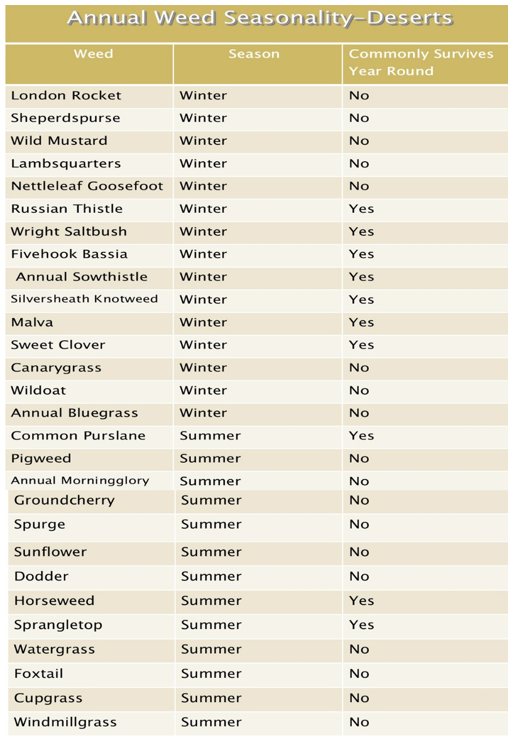
|
|
|
|

|
|||
|
|
|||
|
|
|||
|
The lifecycle of weeds is normally classified as summer annuals, winter annuals,
biennials and perennials. Summer annuals typically germinate in the spring, live
for one season and die during the winter. If left until maturity, they will produce
seed during this season. Winter annuals germinate in the late summer, fall and winter.
They grow vegetatively until the spring when they develop flowers and seed. Biennials
are weeds that by definition live for two years. They germinate in the spring of
the first year, grow vegetatively through the summer and winter of this year and
finally mature and produce seed during the second summer. There are not many true
biennials in the low deserts of Arizona but many so-called annual weeds live for
more than one year. It is not uncommon for some winter annual weeds to live for
more than two years as biennials or even longer as a week perennial. Similarly,
winter annual weeds can sometimes survive through this summer where they are shaded
by a crop and received frequent irrigations. This does not occur with all species
or even with all of a particular species in the same field. This has practical implications
on weed management practices, four instance, where pre-emergent herbicides are used
to control seedling weeds and are ineffective on those that were established in
the previous seasons. The following table lists some of the common annual weeds
and those that can survive year long.

To contact Barry Tickes go to: btickes@ag.arizona.edu.
|
|||
| Back | |||
|
For questions or comments on any of the topics please contact Marco Pena at the Yuma Agricultural Center.
|
|||
|
Home |
Cotton | Veggies |
Forages | Grains
| Citrus |
Crop x Crop Insects | Diseases| Weeds | Pesticides | Economics | News | Weather | Research | Photos | Contacts | General Info. Copyright © 2001 University of Arizona, College of Agriculture and Life Sciences Webmaster: Al Fournier (acis@ag.arizona.edu) |
|||
